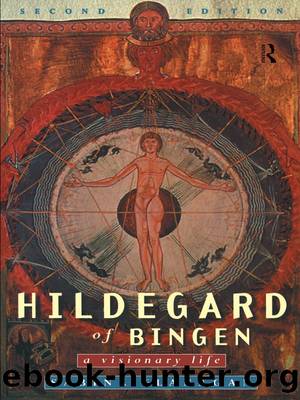Hildegard of Bingen by Sabina Flanagan

Author:Sabina Flanagan [SABINA FLANAGAN]
Language: eng
Format: epub
Publisher: Taylor and Francis
Published: 2011-08-24T00:00:00+00:00
6 The virtues. The illustration shows blind arcades pierced at various times by Godâs mercy, allowing in knowledge of the divine. Scivias, 3, 6, Eibingen MS.
2 O blessed boyhood
shining in the dawn
and O praiseworthy youth
flaming in the sun.
For you, O noble Rupert,
shine like a jewel in them
whence you cannot be hidden by fools
just as the valley cannot hide the mountain.
These stanzas are the only concession to a description of Rupertâs life and subsequent cult in the poem. The fools is probably a reference to the Vikings who sacked Bingen and destroyed the shrine of St Rupert in the ninth century. The mountains and valleys could, as Dronke suggests, be a play on wordsâRupertsberg being identified in a direct way with Rupert. We may recall that St Disibod was also apostrophized as a mountain. The next stanza returns to the heavenly Jerusalem with which Rupert is linked, by describing him as shining in its windows. Whether at this stage Hildegard is referring to St Rupert as he was on earth or in his present sanctified state is unclear. If the latter, being reflected in the windows would seem to put him outside the heavenly Jerusalem, but perhaps too much can be made of the distinction between this life and the next. Hildegard emphasizes that St Rupertâs earthly life was nothing if not an anticipation of his ultimate state.
3 Your windows, Jerusalem
with topaz and sapphire are excellently adorned.
You shine in them, O Rupert, and cannot be hidden
from those of little faithâ
like the valley and the mountain,
crowned with roses, lilies and purple in a true showing.
This stanza may also allude to Hildegardâs re-establishment of worship at Rupertsberg by founding her monastery there, the plan for which she attributed to âa true showingâ. We may recall that she was hindered for a time in this by people, including the monks at Disibodenberg, who had little faith in her plans. The mention of flowers, referring both to Rupert and Rupertsberg leads on to an apostrophe of him in terms ultimately derived from the Song of Songs, and also as a perfect and unsullied urn:
4 O tender flower of the meadow
and O sweet sap of the apple
and O harvest without pith
which does not divert hearts to sin.
O noble vessel which is not defiled
or consumed in the dance
of the ancient cave, and which is not oozing
with wounds of the ancient destroyer.
The juxtaposition of two images here, one positive and one negative, with its apparent reference to pagan ritual, serves to reinforce the description of Rupertâs excellence in an unexpected manner. It is extended in the next stanzas, where the dance becomes angelic and the vessel one of purity, accompanied by the spiritualized smells of good works:
5 In you the Holy Spirit makes music
because you are numbered in the angelic chorus
and shine in the Son of God
since you have no stain.
6 What a seemly vessel you are O Rupert,
who in your childhood and youth
sighed for God in the fear of God
in the embrace of love
and the most sweet odour of good works.
Download
This site does not store any files on its server. We only index and link to content provided by other sites. Please contact the content providers to delete copyright contents if any and email us, we'll remove relevant links or contents immediately.
Resisting Happiness by Matthew Kelly(2913)
The Social Psychology of Inequality by Unknown(2346)
Designing Your Life by Bill Burnett(2309)
Day by Elie Wiesel(2267)
The Giving Tree by Shel Silverstein(1867)
Angels of God: The Bible, the Church and the Heavenly Hosts by Mike Aquilina(1648)
Human Design by Chetan Parkyn(1598)
Augustine: Conversions to Confessions by Robin Lane Fox(1486)
The Supreme Gift by Paulo Coelho(1469)
Hostage to the Devil by Malachi Martin(1416)
Jesus of Nazareth by Joseph Ratzinger(1410)
7 Secrets of Divine Mercy by Vinny Flynn(1408)
Dark Mysteries of the Vatican by H. Paul Jeffers(1367)
The Vatican Pimpernel by Brian Fleming(1359)
St. Thomas Aquinas by G. K. Chesterton(1333)
Saints & Angels by Doreen Virtue(1324)
My Daily Catholic Bible, NABRE by Thigpen Edited by Dr. Paul(1222)
Called to Life by Jacques Philippe(1216)
The Ratline by Philippe Sands(1186)
